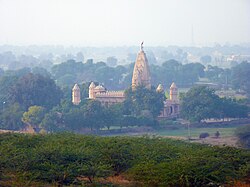
| Agroha Dham | |
|---|---|
Agroha Dham | |
| Religion | |
| Affiliation | Hinduism |
| District | Hisar |
| Deity | Mahalakshmi |
| Festivals | Agroha Maha Kumbh |
| Governing body | Agroha Vikas Trust |
| Location | |
| Location | Agroha (town) |
| State | Haryana |
| Country | India |
 Interactive map of Agroha Dham | |
| Coordinates | 29°19′54″N75°37′31″E / 29.33167°N 75.62528°E |
| Architecture | |
| Type | Vastu Shastra |
| Creator | Tilak Raj Aggarwal |
| Established | 1984 |
| Completed | 1984 |
| Specifications | |
| Temple | 3 |
| Monument | 1 |
| Website | |
| http://www.agroha.com/ | |
Agroha is a Hindu temple complex in Agroha city of Hisar District of Haryana state of India. Construction started in 1976 and was completed in 1984. [1] The main temple is dedicated to the Hindu goddess Mahalakshmi. The temple complex is located adjacent to the Agroha Mound and near Maharaja Agrasen Medical College.


